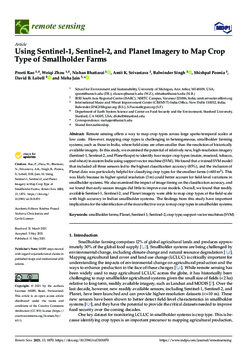Using Sentinel-1, Sentinel-2, and Planet imagery to map crop type of smallholder farms
Abstract
Remote sensing offers a way to map crop types across large spatio-temporal scales at low costs. However, mapping crop types is challenging in heterogeneous, smallholder farming systems, such as those in India, where field sizes are often smaller than the resolution of historically available imagery. In this study, we examined the potential of relatively new, high-resolution imagery (Sentinel-1, Sentinel-2, and PlanetScope) to identify four major crop types (maize, mustard, tobacco, and wheat) in eastern India using support vector machine (SVM). We found that a trained SVM model that included all three sensors led to the highest classification accuracy (85%), and the inclusion of Planet data was particularly helpful for classifying crop types for the smallest farms (

